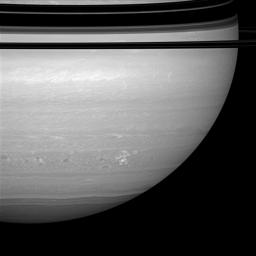
|
Continuing Storm
- Click the image above for a larger view
- Full-Res JPEG (1020 x 1020) (73.6 kB)
- Full-Res TIFF (1020 x 1020) (1.0 MB)
Caption:
The longest-lived continuously monitored electrical storm ever observed on Saturn continues to churn through the tempest-tossed region nicknamed "Storm Alley" because of its preponderance of storm activity.
This image of the storm was taken about five months after it was first detected by Cassini's imaging cameras and the radio and plasma wave science experiment (see PIA08410 ).
This view looks toward the unilluminated side of the rings from about a degree above the ringplane. The bands of the ring shadows blanket the planet at the top of the scene.
The image was taken with the Cassini spacecraft wide-angle camera on April 23, 2008 using a combination of spectral filters sensitive to wavelengths of polarized infrared light centered at 752 nanometers. The view was acquired at a distance of approximately 1.2 million kilometers (760,000 miles) from Saturn. Image scale is 70 kilometers (43 miles) per pixel.
Background Info:
The Cassini-Huygens mission is a cooperative project of NASA, the European Space Agency and the Italian Space Agency. The Jet Propulsion Laboratory, a division of the California Institute of Technology in Pasadena, manages the mission for NASA's Science Mission Directorate, Washington, D.C. The Cassini orbiter and its two onboard cameras were designed, developed and assembled at JPL. The imaging operations center is based at the Space Science Institute in Boulder, Colo.
For more information about the Cassini-Huygens mission visit http://saturn.jpl.nasa.gov/ . The Cassini imaging team homepage is at http://ciclops.org .
Cataloging Keywords:
| Name | Value | Additional Values |
|---|---|---|
| Target | Saturn | |
| System | ||
| Target Type | Planet | |
| Mission | Cassini-Huygens | |
| Instrument Host | Cassini Orbiter | |
| Host Type | Orbiter | |
| Instrument | Imaging Science Subsystem (ISS) | |
| Detector | Wide Angle Camera | |
| Extra Keywords | Atmosphere, Grayscale, Infrared, Radio, Shadow, Storm, Visual | |
| Acquisition Date | ||
| Release Date | 2008-05-13 | |
| Date in Caption | 2008-04-23 | |
| Image Credit | NASA/JPL/Space Science Institute | |
| Source | photojournal.jpl.nasa.gov/catalog/PIA09900 | |
| Identifier | PIA09900 | |
